This post may contain affiliate links. If you purchase with the discount link I provide, Anton Gorlin Photography may earn an affiliate commission. Please read our disclosure for more info. In short, you are getting a discount, and I’m getting a commission.
Table of Contents
- Initial Setup
- Themes
- Galleries
- SEO
- E-Commerce
- Speed and Performance
- Client Proofing
- Plans
- Pricing
- Verdict
- 15% Discount Code
This time I’ve decided to review the website builder I’m most familiar with. I’ve been using it for several years. In this article, I’m going to cover the functionality and commercial possibilities – both pros and cons. Let’s see how I thrived with SmugMug and what happened next.
Initial Setup
Once you sign up, you’ll see a theme selection right away. All the modern layouts are there, and you’ll be able to change later if you like as well. The great feature is that you can also preview straight away.
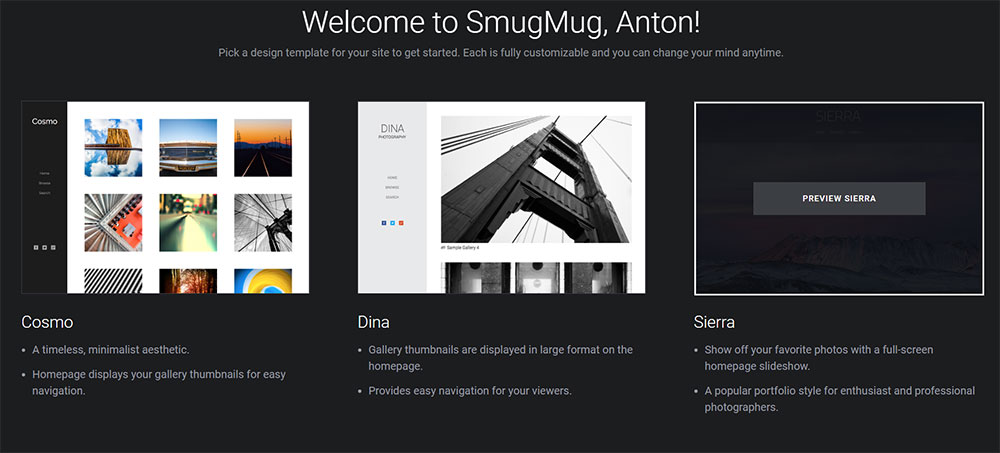
I’ve selected an Osiris theme as I like how it positions photos. After that, the wizard gets me into my first gallery creation. I’ve uploaded a few seascapes and also entered my primary social media sites.
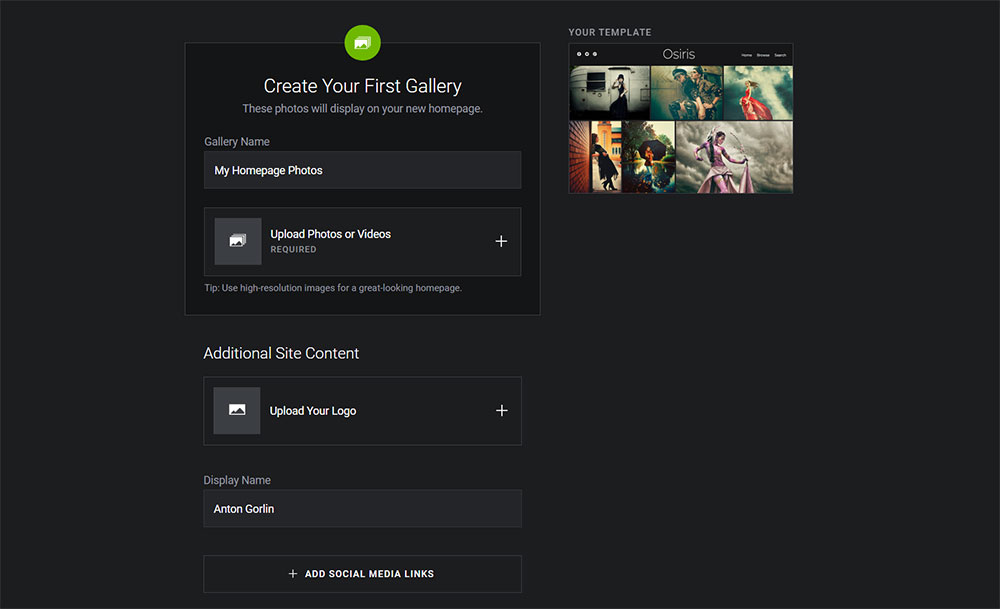
My first impression is excellent as SmugMug showed my site quite fast and without compression artifacts visible in the photos.
The general workflow is intuitive – most of the things I need are already on the menu at the top. I can add more photos to the current gallery (Upload) or create a new one (Organize). Every step you take is supported by the interactive wizard hints to get you through the process smoothly.
Here is how to create a new Gallery, for example:
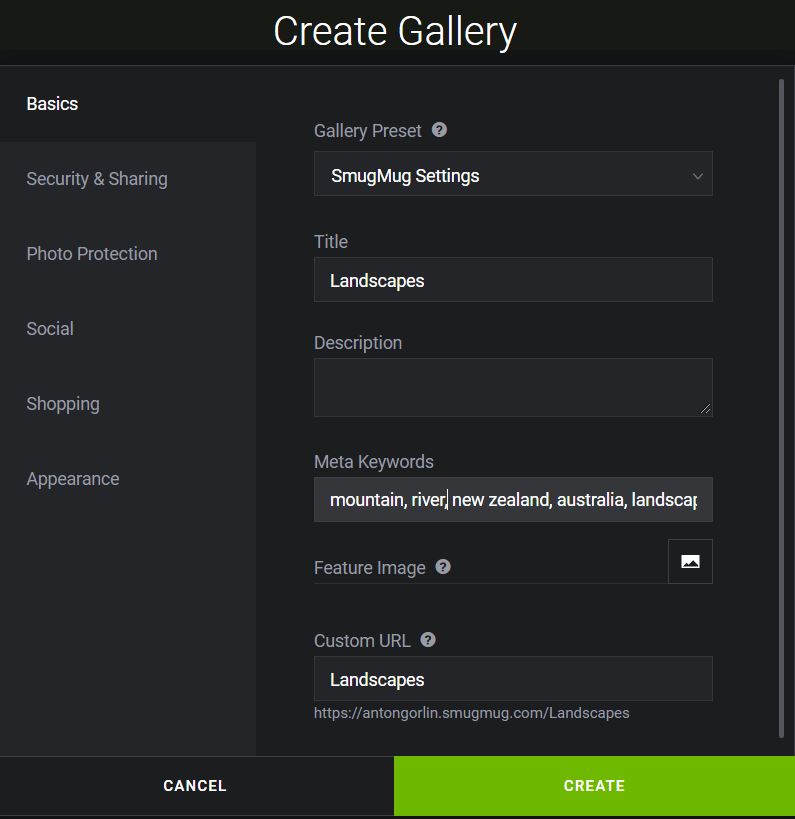
You can customize any gallery by making it password-protected or a client gallery or by changing any of the many parameters. All these settings look quite flexible and easy to understand and manage. Not all of these options are available for the smaller plans as you probably figure. I don’t see much reason to go deeper into these settings—an overall impression – a reliable product with lots of neat and handy features.
Themes
I have already mentioned that there are plenty of themes here and it’s not just that – you may customize each one with small design features and colours. Have a look at the Customize menu and spend some time making it look like you wish. Through the same menu, you may select a site-wide template and change it any time later.
Galleries
All previous functionality is present in most modern website builders in one way or another. Galleries and the process of creation of the site structure is where we could expect some differences to bubble up.
At first sight, it’s not much – you can select one of the four galley layouts. Grid, Vertical, Collage Landscape, Collage Portrait. But on the second tab, there are some options that you can apply to customize it even more. For instance, they have finally added an ability to show photo info under each photo. Years back, I had to dig into the templates and edit javascript by myself.
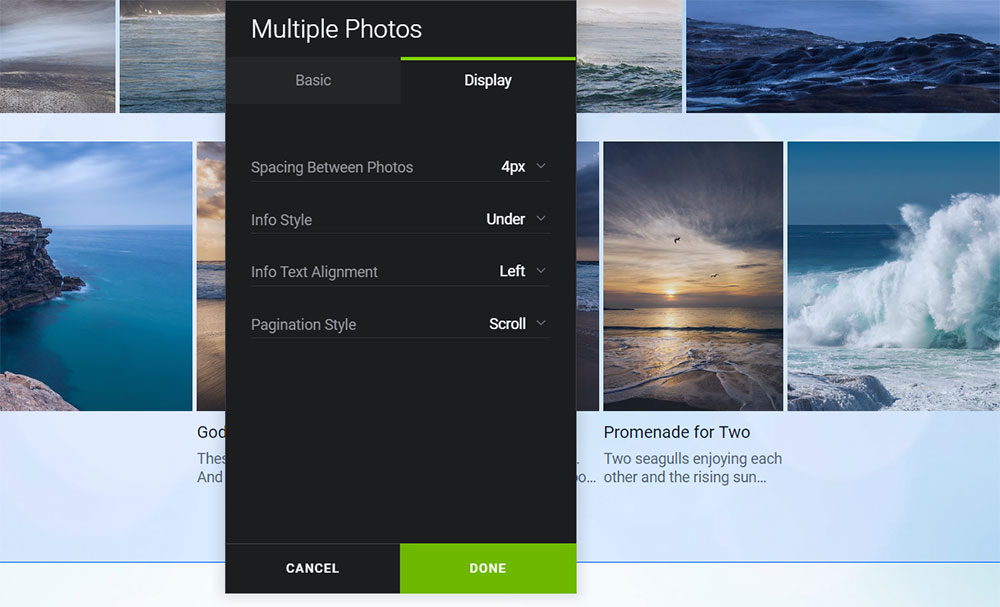
Main points:
- It is possible to have multiple galleries on a single page – just add a folder and then attach galleries to it.
- Each photo has its page, not the gallery page with some anchor # – good for SEO.
- All industry-standard functionality is there – slideshow, buy button, etc.
- Each photo can have its text and description.
- Through Content and Design menu option, you can modify gallery style to include photo names and descriptions (but not just titles).
- Galleries have million of settings including watermarking, right-click protection, download buttons, password-protected downloads, etc.
Blog, About, Contact Pages
There is no blog as such. You’ll have to add a Blog folder, then create a Custom page each time and manually put it under that folder.
There are templates for other standard pages like About or Contact. The Pricing page is a handy template for listing your services or products.
SEO
SEO stands for Search Engine Optimization. And if you want to get it right, you need a custom site or at least a WordPress site. Otherwise, it’s a compromise. But let’s see what SmugMug has to offer in this area. Each page will have a page title, description and keywords.
Headers
Headers structure is essential. You have to have one h1 header, and it may include multiple h2, which include several h3, etc. Should be all logical and should follow the hierarchy. That’s how search engines read our sites.
So I went to my home page and added some headers via the Content and Design menu.
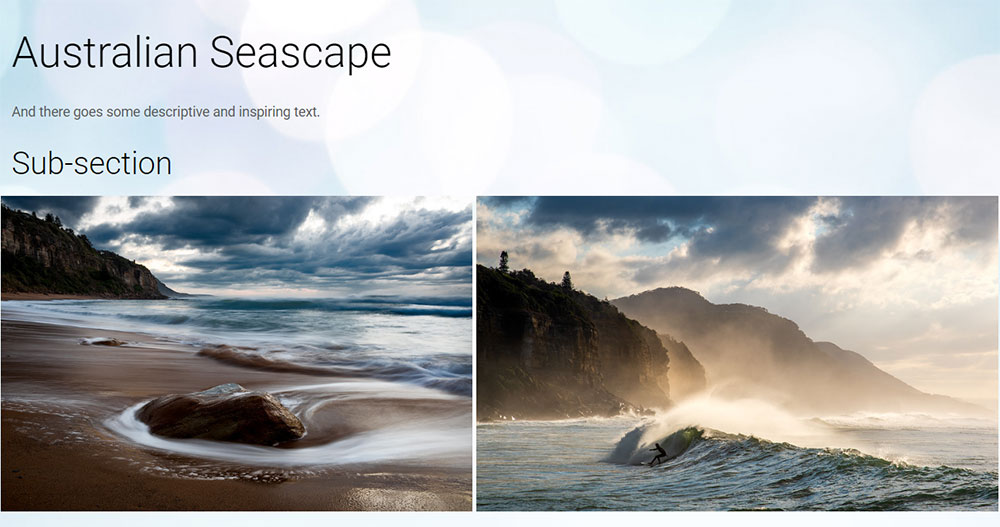
While you can control headers size, you can’t control its type – a real bummer. Whatever you add, it’s h1. However, if you ditch the Title component and add a Text one, you can specify headers in there h1 to h4. So – this one passes, you can have headers in most situations.
Optimization
Some CSS and js files have minification, some are not. HTML does not have it. However, it seems, the pages do not load unnecessary scripts and styles, which is excellent.
Schema.org
Schema.org implementation is barely existent throughout the site. Just like any other website builder I’ve seen. Image galleries will have only one mention of “ImageGallery” type at the top, and all other pages are of a “Thing” type including About Me page. Thanks. This situation is not better and not worse than any other website builder. Nevertheless, it’s one of the crucial features to have, especially if you are a local business type of photographer, not just showing pics or selling prints.
URLs
The URL structure on SmugMug sites historically has pros and cons. The good part is that each photo has a separate page without any anchors in the address. The bad part is that it’s not customizable, i.e. the ending part of the link would look something like this: ../Galleries/Seascapes/i-2ZV4Mhw, which is not readable and can’t be memorized and won’t add to your SEO as well. But having a separate linkable page is already robust and good enough to mark this test as passed.
Social Sharing
Sharing is quite impressive. It doesn’t have lots of social media built-in, but instead, it does have an ability just to customize and copy a direct photo link, or a link to the shopping cart or other options. You can later post them wherever you like. There are options to auto-post to Facebook and Twitter.
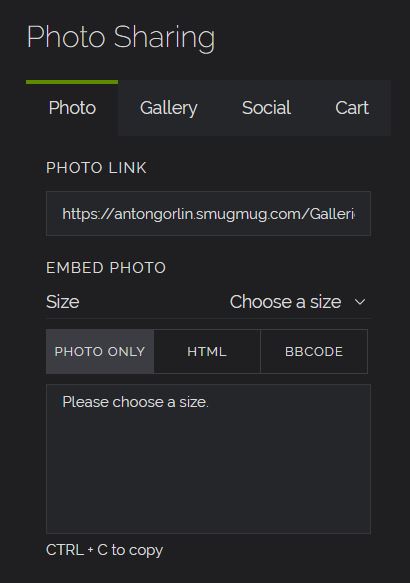
E-commerce
Apart from SEO, e-commerce is an essential part of any website to me these days. Therefore, I was a bit picky here. Also, as a commercial photographer, I sell services. As a blogger, I sell digital products. Apparently, that’s a lot of things to cover for the site builder.
Selling Prints
Below is my list of requirements with some comments:
- Bulk upload. No issues here, all covered.
- Multiple price lists. You can have numerous pricelists – any combination of prices and print labs. However, only one print lab per pricelist, no flexibility here.
- Auto-fulfillment. They have four print labs. Three of them are in the US, and one is in Scotland. None require you to create an account with to be US-based. They offer no self-fulfilment. This positioning means, if your customers are from Australia, they’ll have to pay top price for the shipping. And you can’t capture orders and print them locally. However, if your customers are from the US or Europe, this issue goes away.
- Product selection is vast and to my taste has more items that I would like to sell. Not a problem though, as I can decide what things to sell.
- Payment gateways – can’t see these settings on trial. From memory, they have PayPal.
- The buying process is robust and the best on the market overall. Intuitive interface, logical flow and layout, easy to understand and follow. Other sites should follow UX from SmugMug. To me, it’s the most significant benefit of the system.
- Shipping options are disappointing. I mean, if you are in the US or Europe, it’s ok – standard prices. If you are in Australia or New Zealand, be prepared for a substantial addition to the price.
- There is no way to have an option for the customer to pick the closest lab to minimize shipping. So, I’ve seen photographers doing two galleries – one with the US lab, the other one with the European lab, which is a bit silly. I’d be happy to sacrifice some unique products and stick to the standard ones for the unified buying process if I had this option.
Overall, selling prints is a pleasant experience with SmugMug with several pain points – lack of Australian labs, no self-fulfilment and no ability to attach multiple price lists to the gallery.
Selling Digital Images
Selling digital items is covered nicely – you can sell images, galleries, videos. There are also two license types – personal and commercial.
Selling Products & Services
Sorry to say, but this is just not supported. You can’t sell e-books or workshops. I mean, you can list all the info and attach a PayPal button copied from PayPal button creator if you really want to. But then you’ll have to process all purchases manually. I must put some emphasis on these PayPal buttons – if you would like to have workshops and add-ons like I have, you’d need like 5-8 buttons per workshop or a colossal drop-down, which doesn’t look professional. Here’s what I have here on my WordPress site:
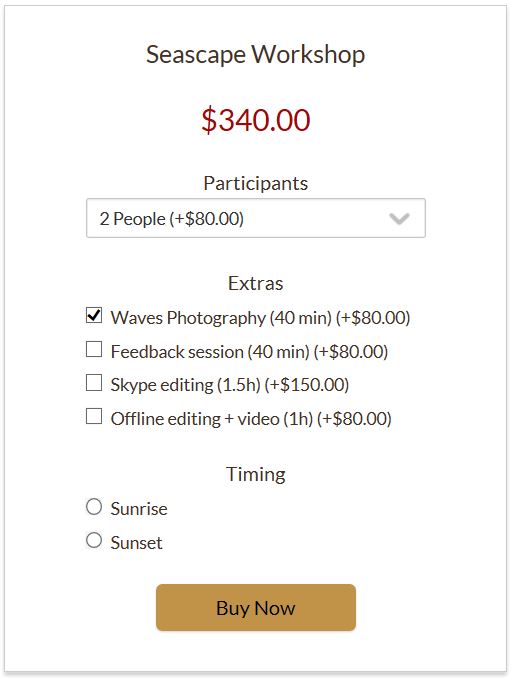
Speed and Performance
To be honest, I don’t expect much from the speed factor of any website builder. But let’s have a look.
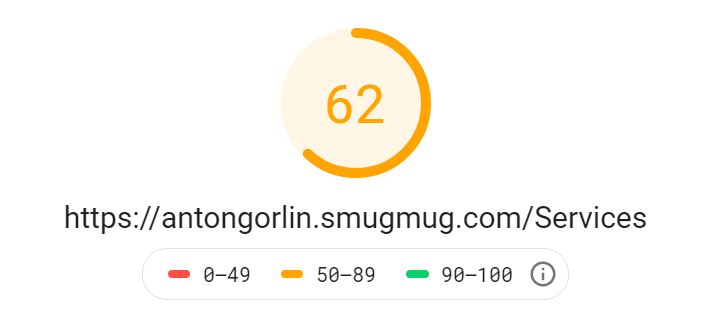
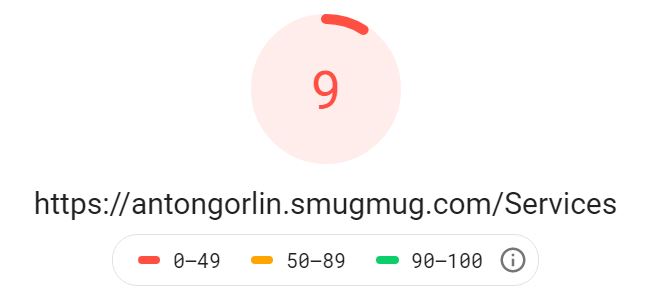
And yet another that I always run shows that the site is fast enough comparing to the competitors – and I’ve tested a page with ten photos and ten paragraphs.
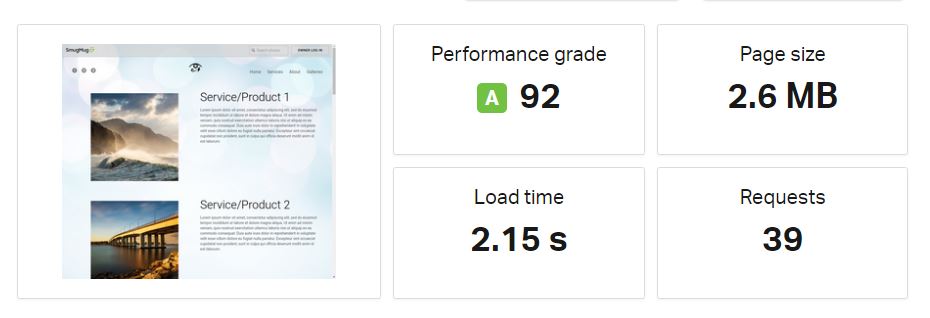
All in all, SmugMug performs better than most competitors in terms of speed and requires some more optimization for mobile devices. Also, automatic photo resizing needs to be optimized.
Client Proofing
SmugMug has a remarkable and very convenient Client Area. For the first time, you share an invitation link with the client, and once they accept, they get access to this section. The clients may browse, comment, download or print photos (if these options are on in the settings).
Plans
The pricing is standard across the leading industry players. Some are way more expensive and several cheaper ones. Basic and Power are not for business, just for showcasing mostly. Portfolio plan is the one I would consider, and it’s unlikely I’d opt-in for the Pro one unless I go deep into commerce (coupons, promotions, personalized price lists per gallery, packages creation, favourite image selection). Some Pro features, however, are quite useful if you do lots of proofing. Also, it goes without saying that you have to select annual payments.

Verdict
So how does it all sum up? I must admit, from all website builders I’ve seen SmugMug is the most intuitive and easy to set up and use. On top of that, page load speed is quite good with an added benefit of pleasant user experience. There are few drawbacks like no self-fulfilment, no Aussie lab, no way to sell digital products or services and limited SEO (which is valid for every website builder). The galleries have multiple styles, and the buyer experience is one of the best on the market. If your intention is just to sell prints or have an excellent looking gallery, SmugMug is a great option.
SmugMug 15% Discount Code
And finally, here is a 15% off link (new accounts only). Enjoy!Your free SmugMug 14-day trial today, and save 15% on a new account.
Mark Schoenfelt says
I have the same problem with my wix website, desktop speed and mobile speed is similar to what you are getting. You mention that the mobile site needs further optimization… what would you do to increase mobile speed? Here is my site… markschoenfelt.com
Anton Gorlin says
hi Mark,
I’m not sure about wix. You should run your site through google page insights and try following their recommendations. However, I’m not sure what you can do with that platform as I haven’t tried it. More often than not, some themes are better optimized, you should pick the best one.